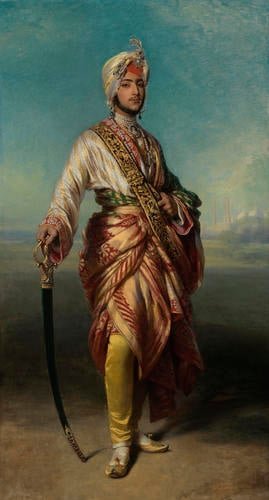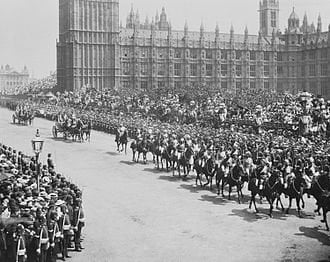Queen Victoria (1837-1901) is synonymous with the British Empire. It was under her reign that the colonial Empire expanded rapidly to the point where ‘the sun never sets on the British Empire’.

A cartoon depicting the assumption of Crown rule in India after the Indian Rebellion of 1857
Victoria was also influential in establishing the modern Monarchy, moving toward a more public-friendly family values and ceremonial institution. Victoria and her husband Albert were viewed by the public largely as the ideal couple and they garnered a repuation for benevolent Christian humanitarians owing to the various causes they championed. Victoria and Albert were noted abolitionists and supported Royal Navy deployments to West Africa in an effort to stop illegal slave trading.
Yet this reputation, sits ill at ease with the reality of imperial rule and expansion under Victoria. Whilst the Monarchy did become more ceremonial over her 64 year reign, she wielded palpable influence, particularly around imperial policy.
Government of India Bill
Victoria influenced the contents of the Government of India Bill 1858 which removed the East India Company from it’s role as the de facto government of India after the Indian Rebellion of 1857, and placed India under Crown rule. Her and Albert insisted on the following provisions
-
Creation of a single army with one chain of command;
-
Commitment from Britain to public works schemes of irrigation and railways;
-
A restriction on the powers and composition of the new advisory Council of India—Victoria was particularly insistent that the new Secretary of State for India should have the power to override the Council;
-
The requirement that the Crown see all dispatches relating to India, as in the existing arrangement with the Foreign Office;
-
All government proclamations in India be made in Victoria’s name;
-
The conciliation of the Indian princes, through respect for their religions, and confirmation of their lineage and legitimacy
A Colonial Custodian
Victoria’s relationship with India is best described as exoticizing and orientalist. She styled herself in the 1860s as ‘Empress of India’, a title that would later be officially bestowed upon her by Parliament in 1876. Victoria saw herself as heir to the Mughal Emperors and to that effect, wore the Koh-I-Noor Diamond on her crown after it’s looting in 1842 from the Sikh Empire.
Indeed, she held this orientalist attitude towards many of the peoples colonised by Britain. One example of this was her adoption of Sarah Forbes Bonetta, born Aina. Aina was a Princess of the Egabo clan taken prisoner by the King of Dahomey. A British officer negotiated her freedom in 1850 specifically as a ‘gift’ for Victoria. Aina was transported to England where she was stripped of her name and christened Sarah Forbes Bonetta. Victoria acted as the child’s patron and godmother, readily taking up the cause of the poor little ‘Dahoman captive’.

Duleep Singh, last Maharajah of the Sikh Empire
Victoria also befriended Duleep Singh, the last Maharajah of the Sikh Empire. This friendship illustrates the conflict between Victoria’s personal relationships and presiding over a global Empire. On one hand, the two enjoyed a close but tumultuous friendship but on the other, Victoria’s forces were the ones who had deposed Singh from his throne. Indeed, it was Victoria herself that attempted to bribe Singh with the offer of making his sons hereditary peers in exchange for his acceptance of Crown ownership of the Koh-I-Noor diamond and other jewels looted by British forces.
Victoria embodied the ‘benevolence’ of British imperialism. Whilst there is no evidence of her directly mistreating Aina or even Singh, they were ultimately subjected to her power, and expected to adhere to British and Western norms. Conversion to Christianity was expected and encouraged. In the case of Singh, he came under pressure to assimilate into the British aristocracy and accept the Crown’s rule over his former kingdom.
Victoria was well informed of colonial policy; whilst she was a self-declared anti-racist and humanitarian, she was an advocate for benevolent imperialism everywhere. She justified the Empire on the basis that the British were kind rulers, especially compared to other Europeans. She was kept regularly informed of developments and often, as in the South African War (1899-1902) displayed a keen determination that the cause of British imperialism should prevail against the resistance of the Boer republics.
Under Victoria, members of the Royal family began to participate more in the ceremonial activities. Her son and heir, the future Edward VII, visited India many times in an official capacity. These visits are the origins of the modern-day Commonwealth tour and the ‘PR Monarchy.’ As the Monarchy gradually lost more of its political power over the running of the Empire, they assumed more and more ceremonial power. The Royal Family came to be the pinnacle of the Empire and the symbol of imperial rule around the globe.

Indian colonial troops parade past the Palace of Westminster during the Queen’s Diamond Jubilee in 1897
The Queen of the Empire
Perhaps the ultimate symbol of the symbiotic relationship between the Empire and Monarchy in the Victorian era was that of the Golden and Diamond Jubilees. Nominally celebrations of the Queen’s reign, both occasions in 1887 and 1897 were massive festivals of Empire. Colonial troops paraded through the streets of London. Exhibitions of far-off colonies were displayed. Union Jacks hung on every corner and God Save the Queen echoed throughout the land. For many, the now doughty Queen Victoria was a proxy for national and imperial pride.
Ultimately, Victoria’s reign can be understood as the first in which the modern relationship between the Monarchy and the Empire was forged. She was the first Monarch to not profit or defend the slave trade and despite her declining policy influence, she and her family assumed the ceremonial role in imperial rule. The Empire gave the Royal Family status and relevance in a fast-evolving country, a symbiotic relationship that continues today under the Commonwealth.